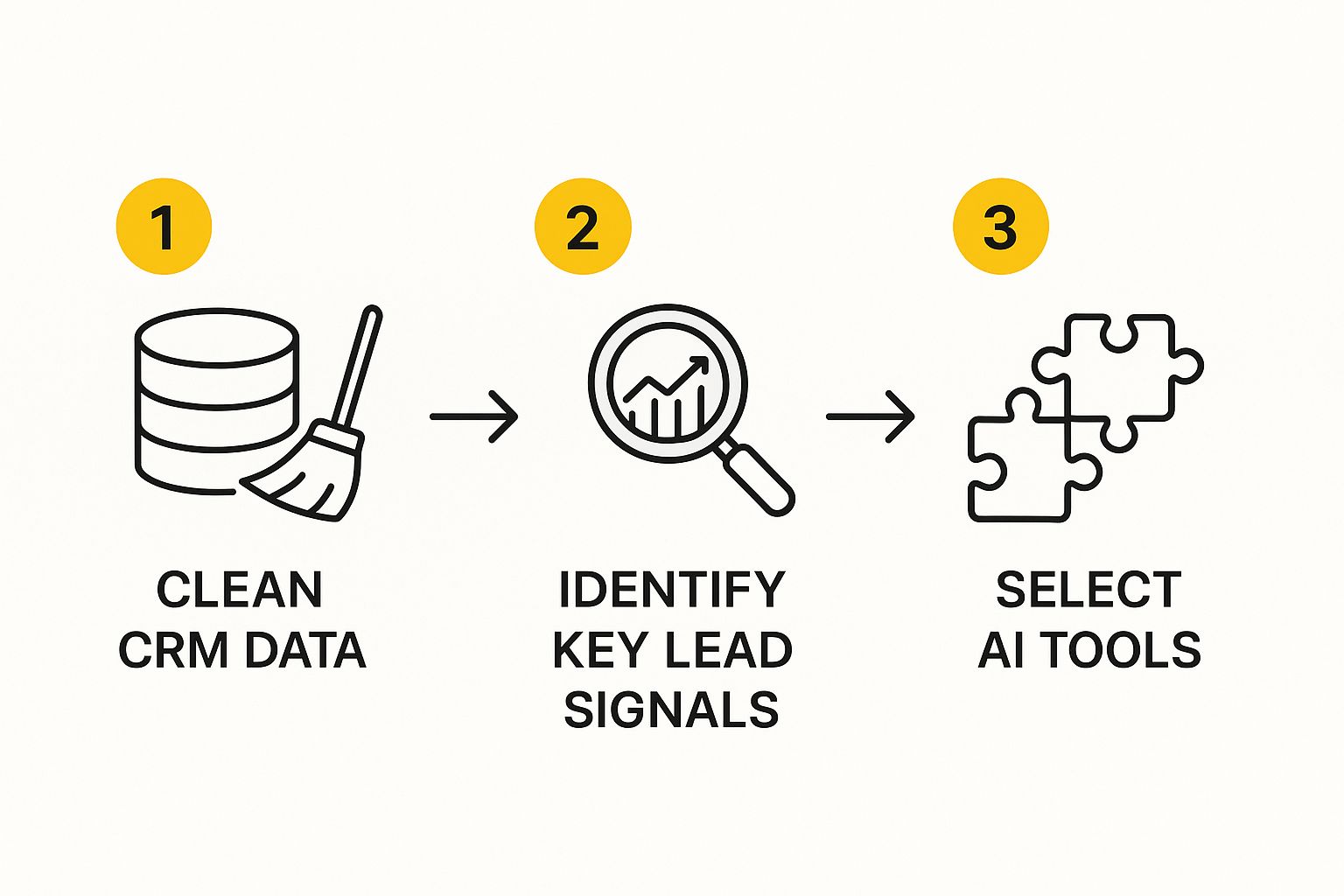Gone are the days of chasing cold leads and relying on gut feelings. AI lead conversion is all about using smart technology to figure out which leads are actually worth your time, personalising how you talk to them, and doing it all automatically. Think of it as swapping out your manual follow-up list for an intelligent system that pinpoints and nurtures your best prospects, giving your efficiency and closing rates a serious boost.
The New Era of Sales: How AI Lead Conversion Works

Welcome to the future of sales, where data-driven decisions call the shots. Making the jump from manual lead nurturing to an intelligent, automated system is a massive shift in how businesses get things done. It’s not just about collecting leads anymore; it's about truly understanding them and engaging with pinpoint accuracy.
An AI lead conversion strategy is your 24/7 sales assistant, making sure no opportunity slips through the cracks. To really get your head around how it works, it helps to first understand the basics of What Is AI Lead Generation, as that’s what sets the whole process in motion.
This isn't just basic automation. We're talking about a smart ecosystem that learns and adapts, freeing up your sales team to focus on conversations that are actually going somewhere.
Breaking Down The Core Process
At its heart, the process is pretty straightforward. First, the AI pulls in data from all over the place—your CRM, website analytics, email chats, and even phone calls. It then sifts through all this info to spot patterns and behaviours that scream "I'm ready to buy!"
This is where the magic really happens. The AI doesn’t just see that a lead checked out your pricing page; it gets the why. It connects that action with other things they’ve done, like downloading a case study or joining a webinar, to build a complete picture of their intent.
The whole point is to ditch the one-size-fits-all approach for a highly targeted strategy. AI gives you the insights to personalise every single interaction, making each lead feel like you genuinely get them.
This smart analysis leads directly to smarter actions. Instead of your team guessing who to call next, the AI hands them a prioritised list of sales-ready leads. It’s a game-changer for efficiency, not to mention a massive morale booster.
To get a clearer picture, let's break down the essential pillars of an AI-driven lead conversion strategy. Each component plays a specific role, working together to turn raw data into closed deals.
Core Components of an AI Lead Conversion System
| Component | Primary Function | Business Impact |
|---|---|---|
| Data Aggregation Engine | Gathers lead data from multiple sources like your CRM, website, and social media. | Creates a single, unified view of each prospect, eliminating data silos. |
| Predictive Scoring Model | Analyses behaviour to predict a lead's likelihood to convert and assigns a score. | Allows your sales team to focus their efforts on the most promising leads first. |
| Personalisation Engine | Customises outreach (emails, messages) based on a lead's specific interests and actions. | Increases engagement and makes prospects feel understood, boosting response rates. |
| Automated Nurturing Workflows | Triggers automated sequences to engage leads at the right time with the right message. | Ensures consistent follow-up without manual effort, moving leads down the funnel. |
These components form the backbone of a system designed to work smarter, not harder.
From Data Points To Deals Closed
Once the AI flags a lead as "hot," it can kick off an automated yet personalised outreach. This could be anything from an email sequence tailored to their interests to a quick alert for a sales rep to pick up the phone. The system makes sure the right message hits the right person at exactly the right time.
This level of intelligence is quickly becoming the norm. Here in Australia, businesses are jumping on board, with research showing over 76% of Australian companies are already using AI tools for their digital marketing. Of those, more than 60% have seen real improvements in customer engagement and conversion rates.
You can even integrate tools like an ai answering service into this workflow. It ensures that even the calls you receive are captured and analysed, making every interaction part of the bigger picture. It’s all about creating a seamless, intelligent system where every touchpoint works towards one goal: closing the deal.
Building Your Foundation with Data and Tools
An AI system is only as good as the data you feed it. Think of it this way: you wouldn't expect a top chef to whip up a gourmet meal with dodgy ingredients. The same logic applies to AI lead conversion; high-quality data is the secret sauce for success.
This means the first, and honestly most critical, step is to get your data house in order. Before you even think about plugging in new tech, you’ve got to focus on what you already have.
Start with a Clean Data Slate
Your Customer Relationship Management (CRM) system is the heart of your entire sales operation. If it's a mess of duplicate entries, old contact details, or inconsistent formatting, your AI will be completely lost and struggle to make accurate predictions.
Start by dedicating some serious time to data hygiene. It's not the most glamorous job, I'll admit, but the payoff is massive. It involves standardising how your team enters data so everyone is capturing information the same way.
A clean, organised CRM is non-negotiable. It's the bedrock upon which your entire AI lead conversion strategy is built. Without it, you're building on shaky ground.
This groundwork ensures your AI has a reliable source of truth to learn from. When your data is clean and structured, the AI can actually start spotting the patterns and signals that point to a sale.
The following infographic breaks down the core process of prepping your data and picking the right tools for the job.

As you can see, a successful setup starts with clean data, moves on to identifying those crucial lead signals, and finishes with choosing the right technology to bring it all together.
Pinpoint Your Key Purchase Signals
With clean data in hand, you can start digging for the key data points that signal a lead is getting warm. These are the digital breadcrumbs your best prospects leave behind.
So, what behaviours truly signal buying intent for your business? It’s different for everyone. For a software company, it might be someone watching a full product demo. For an e-commerce store, it could be a visitor who keeps adding the same items to their cart.
Look for patterns in your history:
- Website Engagement: Which pages do your best customers always seem to visit before they buy? Is it the pricing page, your case studies, or the technical specs?
- Content Consumption: Do the leads who download your "Ultimate Guide" convert at a higher rate than those who just skim a few blog posts?
- Communication History: How many emails are usually exchanged before a deal closes? What's the general feeling or sentiment in those conversations?
Spotting these signals is all about connecting actions to outcomes. This allows you to program your AI to recognise these high-value behaviours in real-time, instantly flagging hot leads for your sales team to jump on.
Selecting the Right AI Toolkit
Once your data is tidy and you know what you’re looking for, it’s time to choose your tools. The market is absolutely flooded with options, from all-in-one platforms to specialised tools for specific jobs like lead scoring or chatbot automation.
To really get ahead, it's crucial to understand and use the most effective, game-changing AI sales tools out there. This isn't about finding the tool with the flashiest features; it’s about finding the one that actually fits what you need to do.
A simple way to choose is by looking at what different types of tools are best for.
Choosing the Right AI Lead Conversion Tool
Here’s a quick comparison of different AI conversion tools to help you pick the best fit for your business needs and budget.
| Tool Category | Best For | Typical Price Range (AU) | Example Integration |
|---|---|---|---|
| Predictive Lead Scoring | Businesses with high lead volume needing to prioritise sales efforts. | $150 – $700+ / month | Salesforce Einstein, HubSpot AI |
| AI Chatbots | E-commerce & SaaS sites wanting 24/7 lead capture and qualification. | $50 – $400 / month | Intercom, Drift |
| Sales Engagement AI | Sales teams looking to automate outreach and analyse communication. | $100 – $300 / user / month | Outreach.io, SalesLoft |
| Conversation Intelligence | Teams wanting to analyse sales calls to improve coaching and performance. | $80 – $200 / user / month | Gong, Chorus.ai |
Ultimately, the goal is to find a solution that not only offers powerful AI features but also slots into your existing workflow without causing a headache.
To help narrow it down, here’s a practical framework for evaluating your options:
- Assess Your Current Tech Stack: Your new AI tool must play nicely with your existing systems, especially your CRM. A clunky integration creates data silos and completely defeats the purpose.
- Consider Your Business Size and Scale: A small business doesn't need a massive, enterprise-level solution. Look for tools that can grow with you, offering scalable pricing and features.
- Define Your Budget: AI tools can range from affordable monthly subscriptions to serious enterprise investments. Set a realistic budget based on the return you expect to see.
Many small businesses find that just choosing the right platform is the biggest hurdle. To get your bearings, checking out a guide on the best CRM programs for small business can give you valuable context on what features are essential for a solid data foundation. The goal is to pick a solution that boosts your existing processes, not blows them up.
Weaving AI into Your Sales Workflow

This is where the rubber meets the road. Moving from a well-laid plan to actually putting it into action can feel like a massive leap, but weaving AI lead conversion tools into your daily sales grind doesn't have to be a huge disruption. The secret? A gradual, methodical rollout that actually helps your team, rather than just giving them another piece of software to learn.
A successful integration is all about introducing AI in stages, hitting the high-impact areas first. This way, you minimise the friction and let your team see the wins for themselves—which is absolutely crucial for getting everyone on board.
The goal is to embed these smart tools so seamlessly into your existing process that your team eventually wonders how they ever got by without them. It’s about giving them superpowers, not replacing them.
Kick Things Off with AI-Powered Lead Scoring
The most logical—and impactful—place to start is with AI-powered lead scoring. This tackles one of the biggest headaches for any sales team: figuring out who on earth to call next. Instead of relying on gut feelings or basic metrics like email opens, you're handing them a priority list backed by cold, hard data.
An AI model chews through thousands of data points—from website behaviour and email engagement to firmographic details—to assign a simple numerical score to every single lead. This score is a direct reflection of their likelihood to convert, instantly showing your team where to focus their energy for the best results.
Think of it as the ultimate filter. It cuts through all the noise and highlights the genuine opportunities, ensuring your team’s precious time is spent on conversations that are actually likely to go somewhere.
By starting with lead scoring, you deliver immediate value to your sales reps. They spend less time chasing duds and more time closing deals, which is the fastest way to prove the ROI of your new setup.
This first step builds momentum and, just as importantly, confidence. Once the team starts having better conversations and seeing sales cycles shrink, they’ll be much more open to adopting the more advanced AI features you have planned.
Deploy Automated and Personalised Nurture Sequences
With your lead scoring system flagging the hottest prospects, the next logical step is to automate how you handle everyone else. Look, plenty of leads are interested but just not ready to pull the trigger right now. This is where automated, yet genuinely personalised, email sequences become your best friend.
Modern AI tools don't just blast out generic follow-ups. They can trigger specific email workflows based on what a lead actually does.
For instance:
- A lead downloads a whitepaper on a specific feature? The AI can automatically send them a case study showing how another company in their industry used that exact feature to solve a problem.
- A prospect keeps visiting your pricing page but doesn't book a demo? A sequence could be triggered offering a one-on-one chat or maybe a special trial offer.
This kind of tailored communication keeps your brand top-of-mind and gently guides leads through the funnel without any manual effort from your team. It means that when they are ready to talk, you're the first company they think of. This goes beyond email, too; you can even automate phone calls for follow-ups or appointment reminders to create a truly comprehensive engagement strategy.
Activate Real-Time Qualification with AI Chatbots
The final piece of this initial integration puzzle is getting an AI chatbot live on your website. Think of chatbots as your 24/7 front-line qualifiers, engaging visitors the moment they land and gathering key info before a human even needs to get involved.
Instead of a boring, static "contact us" form, a chatbot can ask targeted questions to understand what a visitor needs in real-time. It can qualify them based on their industry, company size, or the specific challenge they're trying to solve.
Based on those answers, the chatbot can then take action:
- Book a demo: For high-intent visitors, it can plug straight into a sales rep's calendar.
- Provide resources: It can point users to the right blog posts, case studies, or FAQs.
- Route to the right team: It can make sure inquiries go directly to sales, support, or marketing, saving everyone a headache.
This instant engagement is a massive improvement to the user experience and ensures you don't lose a potential lead just because they visited your site after hours. It’s a seriously efficient way to capture and qualify leads around the clock.
Putting It All Together: A Real-World Scenario
Let's picture a B2B company that sells project management software. They decide to implement this phased approach.
First, their new AI tool starts scoring all their trial sign-ups. Right away, their sales team notices they're connecting with leads who have a genuine need and budget, boosting their meeting booking rate by 30%.
Next, they set up automated nurture sequences. Leads who go quiet during the trial start receiving helpful tips and case studies relevant to their industry. This simple step reactivates 15% of previously dormant leads.
Finally, their new website chatbot starts qualifying visitors, booking demos directly for enterprise-level inquiries and shielding the sales team from answering basic questions. This strategic integration transforms their sales workflow from a manual slog into a well-oiled, efficient machine for AI lead conversion.
Optimizing and Personalizing at Scale
Getting your AI system up and running is a huge milestone, but the real magic of AI lead conversion happens next—through constant tweaking and optimisation. Once the engine is purring, it's time to start fine-tuning its performance. The aim here is to ditch the generic, one-size-fits-all marketing and start creating hyper-personalised experiences that don't just get noticed, but actually drive sales.
This is where machine learning really shows its strength. It’s not about just automating what you’re already doing. It’s about using AI to learn, adapt, and have one-on-one conversations, but on a massive scale. Think of it like having a dedicated data scientist for every single lead, always working out what makes them tick.
The whole process involves letting the AI figure out which messages, offers, and communication styles click best with different customer segments. It's a continuous cycle of testing and refining that just gets smarter the longer it runs.
Accelerate Your Learning with AI-Powered Testing
Traditionally, A/B testing is a bit of a slow grind. You test one thing, wait for the data to trickle in, analyse the results, and then do it all over again. It works, but getting any real insight can take months. AI completely flips this on its head by putting the entire learning cycle on fast-forward.
Instead of just running a simple A/B test, you can unleash multi-variate testing where the AI juggles dozens of combinations at once.
- Email Subject Lines: Test out different tones, lengths, and value propositions to see what hooks specific audience segments and gets them to open your emails.
- Chatbot Scripts: Play around with various opening lines, qualification questions, and calls-to-action to find the perfect flow for real-time chats.
- Landing Page Copy: Let the AI test different headlines, benefit-driven statements, and button text to discover which combo gets the most form fills.
The AI does more than just pick a winner; it spots the subtle patterns you’d probably miss. For instance, it might find that leads from the finance sector love data-heavy subject lines, while those in creative industries are more likely to click on something benefit-focused.
The real advantage is the speed and depth of the insights. An AI can run thousands of micro-experiments in the time it takes a human to set up just one, digging up gold that would otherwise stay buried.
This rapid feedback loop means you can make smarter decisions, faster. Your messaging is always evolving to meet what your customers actually want, taking the guesswork out of your marketing.
Activate Dynamic Content Personalization
All this testing and learning is leading to one thing: delivering truly dynamic content. This is where your website, emails, and even your ads automatically change to show each visitor the most relevant info based on who they are and what they’ve done.
Picture a potential customer landing on your website. Instead of a generic homepage, they’re greeted with a headline and case studies that speak directly to their industry. That’s dynamic personalisation in action, and it's a massive driver of AI lead conversion.
Here’s a quick look at how it works behind the scenes:
- Data Collection: The AI pulls together information about a visitor—their location, which pages they’ve looked at, any content they’ve downloaded, plus data from your CRM.
- Real-Time Analysis: It then instantly crunches this data to figure out what the visitor is interested in and what they’re likely to do next.
- Content Adaptation: Based on that analysis, the content on the page shifts. An e-commerce site might show products similar to ones they’ve already viewed. A B2B site might highlight features that are most relevant to their company size.
This is a world away from just dropping a lead’s first name into an email. It’s about crafting a unique journey for every single person, making them feel like you genuinely get them.
For example, a real estate agency using this could automatically show a visitor from Sydney properties in their price bracket, while someone browsing from Melbourne sees relevant local listings. This kind of relevance makes the whole experience way more engaging and seriously boosts the chances of conversion. When your content speaks directly to a user's needs, they pay attention, and you can guide them much more effectively towards a sale.
Measuring Success and Proving ROI

So, you’ve put an AI lead conversion strategy in place. That’s a massive step, but the real question is, how do you know if it’s actually working? To justify the time and money spent, you need to be tracking the right numbers. It’s time to move past surface-level stats like website traffic and zero in on the data that directly affects your bottom line.
Proving the return on investment (ROI) isn’t just about showing the tech is doing something. It's about demonstrating its real, tangible contribution to revenue. This means setting up clear dashboards and tracking the key performance indicators (KPIs) that tell a powerful story about your efficiency and profitability.
Ultimately, the goal is to connect the dots. When you can clearly show how AI is shortening your sales cycles or boosting customer value, getting the green light for future investments becomes a whole lot easier.
Moving Beyond Vanity Metrics
First things first: stop obsessing over vanity metrics and start focusing on numbers that lead to action. Sure, it’s great to see more website visitors, but that figure tells you nothing about whether they're turning into paying customers. Real success is measured by improvements across the entire sales funnel.
Here are the core metrics I always tell my clients to track when measuring their AI lead conversion efforts:
- Lead-to-Customer Conversion Rate: This is the big one. It’s the percentage of leads who actually become paying customers. If this rate is climbing, it’s a solid sign your AI is doing its job identifying and nurturing the right people.
- Sales Cycle Length: How long does it take for a lead to go from their first "hello" to a signed deal? A good AI setup should shrink this timeline by prioritising hot leads and automating follow-ups, freeing up your team to close deals faster. Track this in days or weeks and watch the trend.
- Cost Per Acquisition (CPA): By getting smarter with targeting and making your process more efficient, AI should drive down the cost of acquiring each new customer. Keeping a close eye on your CPA is essential for proving that your investment is making your sales machine more cost-effective.
Tracking these KPIs gives you a clear, data-backed picture of how your AI is performing. It shifts the conversation from, "I think this is working," to, "I can prove this is working."
Building Your AI Performance Dashboard
To keep these crucial numbers front and centre, you need a dedicated performance dashboard. This doesn't need to be some overly complex beast. You can use your existing CRM or a business intelligence tool to create a visual report that everyone on your team can understand at a glance.
Your dashboard should be a snapshot of your most important KPIs, comparing current performance against historical benchmarks. For instance, you could show the sales cycle length this quarter compared to the same quarter last year, before you brought the AI system on board.
A well-designed dashboard becomes your single source of truth. It cuts through the noise and allows for quick, informed decisions based on real-time data, ensuring your strategy stays on track.
It's also worth looking at engagement versus actual conversion. Interestingly, while traffic driven by AI often shows higher engagement, converting these leads can throw up some unique challenges. Recent data shows that even though AI traffic generates 37% lower bounce rates, conversion rates from AI referrals in Australia are still playing catch-up with traditional sources. You can explore this trend and see how the gap is closing in this comprehensive Q2 analysis. Knowing this helps set realistic expectations and fine-tune your funnel for these specific leads.
Connecting Metrics to Revenue
The final piece of the puzzle is tying these metrics directly to revenue. It’s not enough to say the sales cycle is shorter; you need to show what that means in dollar terms.
Start by calculating your Customer Lifetime Value (CLV). A smart AI strategy shouldn’t just bring in more customers, but also attract higher-quality customers who stick around longer and spend more. If your CLV is on the rise, it’s a powerful sign that your AI is successfully identifying your ideal customer profiles.
When you combine metrics like an improved conversion rate, a shorter sales cycle, and a higher CLV, you can build an incredibly powerful business case. You can confidently show that your AI lead conversion system isn’t just another expense—it’s a revenue-generating engine for your business.
Got Questions About AI Lead Conversion?
Diving into AI for your sales process is a big move, and it’s smart to have a few questions. Shifting gears to a more data-driven approach is a significant step, so it’s only natural to want the full picture before you jump in. Let's tackle some of the most common queries we hear from businesses, with straight-up answers to help you know what to expect.
How Much Does It Really Cost to Get Started?
Honestly, the price tag for an AI lead conversion system can swing pretty wildly depending on what you need. If you're a small business just dipping your toes in, you can find entry-level tools for chatbots or basic lead scoring for a very reasonable $50 to $200 AUD per month.
For mid-sized companies wanting something a bit meatier that plugs right into their CRM, you’re probably looking at a monthly cost between $500 and $2,000 AUD. And for the big players at the enterprise level, where you need custom-built solutions and heavy-duty data modelling, the investment can easily top $5,000 AUD a month.
The trick is to start with a clear goal and pick a tool that can grow with your business. A lot of providers offer free trials, which are a brilliant way to see what the tech can do before you sign on the dotted line.
Is AI Going to Make My Sales Team Redundant?
This is the big one, isn't it? And the answer is a firm no. AI is here to supercharge your sales team, not replace them. Its real job is to take all the repetitive, soul-crushing tasks off their plate – think initial lead qualification, mind-numbing data entry, and sending out those standard follow-up emails.
This frees up your sales pros to do what they do best: building real relationships with customers, navigating tricky negotiations, and closing those high-value deals.
Think of AI as the ultimate sales assistant. It’s on the job 24/7, making sure your team is only ever talking to the most qualified, sales-ready leads. It empowers them to be way more efficient and effective.
Basically, AI handles the science, so your team can focus on the art of selling.
How Long Before I Actually See Results?
The timeline really depends on a few things: the state of your current data, how long your sales cycle is, and how complex your setup is. Some businesses start seeing small wins—like better quality leads getting passed to the sales team—within the first 30 to 60 days.
But for a really noticeable impact on your conversion rates and revenue, it’s more realistic to think in terms of 3 to 6 months. This gives the AI model enough time to chew on the data, learn from all the interactions, and really start optimising its game. A bit of patience and a commitment to tweaking things along the way are your best friends here.
What Are the Biggest Headaches During Implementation?
The most common roadblocks we see are dodgy data quality, not having the right skills in-house, and a bit of natural resistance from the team. That old saying "garbage in, garbage out" has never been more true than with AI. If your CRM data is a mess, the AI’s predictions won't be worth much. You absolutely have to invest time in cleaning up your data before you start.
The skills gap is another hurdle. You either need someone on your team who gets the tech or a solid implementation partner to guide you.
Finally, you might find some of your sales crew are a bit sceptical. The best way to get them on board is to:
- Be Open: Clearly explain why you're making the change and what's in it for them (less admin, more commissions!).
- Train Them Up: Make sure everyone feels comfortable and confident using the new tools.
- Show, Don't Just Tell: Highlight the early wins. Nothing convinces a salesperson like seeing how AI is helping them close more deals and smash their targets.
At OnSilent, we know that managing your leads efficiently is what fuels growth. Our AI Call Assistant is built to cut through the noise so you can focus on the conversations that actually matter. Stop wasting time on spam calls and letting good opportunities slip through the cracks.
Discover how OnSilent can transform your lead management today

